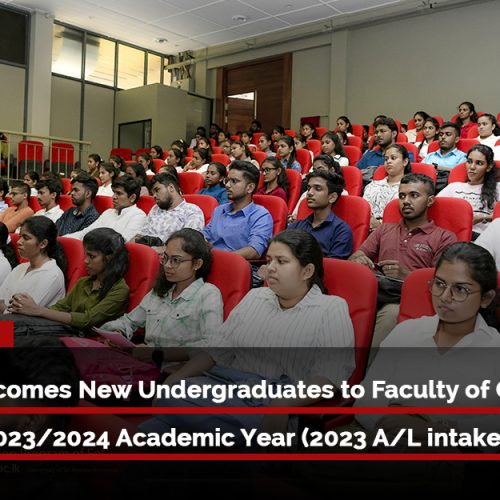In managing our lives successfully, we draw inspiration mainly from religion and/or philosophy. It is widely accepted that our lives can be beautifully shaped by applying the teachings of religious leaders such as the Lord Buddha, Jesus Christ, and the Prophet Muhammad Nabi and the theories of philosophers such as Socrates, Plato, Aristotle, Nietzsche, Bertrand Russell, Krishnamurthy, and Lu Xun.
Art, literature and aesthetics
 There is also another very important source from which we can draw inspiration in managing our lives effectively and meaningfully: art, literature and aesthetics. What is art? How did art originate? What is its purpose? Is it only for the sake of amusement? Or is it for the sake of the progress and the celebration of the superiority of mankind? What is its contribution towards creating a new man, new society and a new world? are some of the questions one can ask in order to better understand the role played by art in shaping human lives.
There is also another very important source from which we can draw inspiration in managing our lives effectively and meaningfully: art, literature and aesthetics. What is art? How did art originate? What is its purpose? Is it only for the sake of amusement? Or is it for the sake of the progress and the celebration of the superiority of mankind? What is its contribution towards creating a new man, new society and a new world? are some of the questions one can ask in order to better understand the role played by art in shaping human lives.
But art is not a simple process. It is an extremely intricate, deep and vast discipline and an evolving phenomenon with its purpose and definitions being subject to revision from time to time.
The earth, which we inhabit, is estimated by geologists to be four thousand six hundred million years old and it was millions of years later that the earth became suitable for human habitation. Thus it can be safely assumed that the current species of human beings are about two million years old.
Origin of art
In the human civilization thus originated and developed, the human activity and thought were two very important factors closely associated with the origin of art. In the beginning, man used activity solely for his survival and he made use of his body to get food, accommodation and clothing. However, it can be assumed that as evolution continued, man used imitation too to fulfill his various needs. Imitation may have originated especially in association with man’s reactions to the unforeseen forces in the physical world that were out of his control or the various mishaps, ailments, fears and terrors posed by the metaphysical world. He may also have resorted to imitation as a means of communicating to the tribesmen the encounters he had had with the wild beasts on hunting expeditions. However, later on imitation was used rhythmically and acoustically and thus it can be assumed that imitation is related to the origin of creative art. One exploring the historical roots of art may also find a close link between the use of human labour and the origin of art.
The second most important factor in the human evolution, thought played a much bigger role in the origin of art. The beauty of Nature surrounding the man inspired him and evoked in him aesthetic thoughts.
Man is different from other living beings due to his capacity for labour, thought and language skills in communication. These distinctive qualities and capacities of the human brain may have inspired and been instrumental in producing art or aesthetic expressions.
It should also be remembered at this juncture the existence of the belief that art or aesthetics is not a creation of man, but a gift of the God. The idealist belief that not only art, but also man is a creation of the God was later challenged by the Theory of Evolution put forth by the scientific school led by Charles Darwin. The Theory of Evolution proves on scientific and historical evidence as well as rational thinking that man evolved from the ape at some point of history. If man is a result of the process of evolution, so is art of the same process is a fair assumption.

It is widely believed that if there is any creation other than what has been created by Nature, it is invariably the result of man’s activity and thought. Various forms of imitation used by man to project his feelings and experiences to other men have been developed into various media and laid the foundation for art to be born. Some historical artifacts that validate this view are 25,000-year-old cave paintings at Altamira in Spain, 17,OOO-year old Lascaux cave art in Southeast France and expressions used to release exhaustion in hard labour, such as folk poetry (paru kavi, nelum kavi, karatta kavi, pel kavi) of ancient Sri Lanka.
Setting aside the numerous notions about the origin of art, let us now briefly examine the purpose of art, which would be very useful in understanding its importance in managing life. India’s Bharata Muni representing the Eastern view pointed out that the purpose of art is to generate sentiments. Greece’s Aristotle representing the Western view saw the purpose of art, with special reference to the theatre, to be the imitation of a task in progress. Marxist aestheticians described art as a symbolic expression of culture. According to Marx, art is a socio-realistic expression of the physical world. If the same view is analyzed from a different angle, art can be defined as the aesthetic reflection of Nature in the human mind.
According to Russia’s greatest novelist Leo Tolstoy, art is a human process by which a man infects others by evoking in them feelings he himself has experienced, with the use of certain external indications. ‘To evoke in oneself a feeling one has once experienced, and having evoked it in oneself, then, by means of movements, lines, colors, sounds, or forms expressed in words, so to transmit that feeling that others may experience the same feeling – this is the activity of art. ‘
The prominent Western critic of the twentieth century 1.A. Richards stated that art is the pinnacle of communication. Pablo Picasso, a foremost painter of the modem art, indirectly expressed his view on the purpose of art in his famous quote: ‘I paint objects as I think them, not as I see them.’ Ingmar Bergman, the world-renowned film director implied his view on art as follows: ‘To shoot afilm is to organise an entire universe.’
Mahagama Sekara, Sri Lanka’s greatest poet of the twentieth century, presented his impression about art in his collection of poems ‘Prabuddha’ in the following lines;
‘0, Lord Buddha,
why did you forsake art?
Art is truth and illusion.
Truth is Nature.
Man can never create anything as beautiful as Nature.
Art is for the novices who cannot see that beauty … ‘
All these expressions are based on one distinctive concept – that is, art is life.
There is also an entire gamut of different views on art put forth at various stages of the human history: art is for the sake of life; art is for the sake of escape from life’s trials and tribulations; art is for the sake of resilience and enjoyment in the face of life’s trials and tribulations; art is for the sake of service; art is for the sake of self-expression; art is for the sake of amusement; art is for the sake of gratification of senses; art is for the sake of art.
I think it opportune to share with you an important quote by Leo Tolstoy on the relationship of art and science: ‘Science and art are as closely bound together as the lungs and the heart, so that if one organ is vitiated the other cannot act rightly.’ What other proof convinces you better that art and science go hand-in-hand with each other?
In exploring the possibilities of using art in managing life, one needs to be aware of the classification of art. Among diverse classifications, art can be classified into fine arts and utility arts; natural arts, folk arts and commercial arts; and also contemporary arts, abstract arts and visual arts.
Visual Arts, Performing Arts and Literature

However, art is an all-embracing term that includes painting, sculpture, carving, photography and architecture under the broad category of ‘visual arts’, dancing, music, theater and cinema under the broad category of ‘performance arts’ and various forms of prose such as novels and short stories and poetry such as ballad, quatrain and free verse under the broad category of ‘literature’. However, this too is not an exhaustive list because with the advent of computer and mobile technology, art is produced in various forms and formats.
It is clear that all these media of art are involved in a communication process – where one’s experience is shared among a number of others. This experience may not necessarily be one’s own; it could be someone else’s too. It could also be an assumed/imagined experience. It is quite common for human beings to share their experiences with others. It is a behavior that comes quite naturally to us to present and share our experiences with others at funerals, weddings, market, on the road, at home or on any other social occasion. It is also one of the conditions ensuring the smooth functioning of society.
Though the same communication process takes place in art, the difference is that the act of communication in art is not made directly. In other words, communication does not take the form of direct reporting. Human experiences are presented to others through art in an implied or indirect manner, in a different form, by translating emotions to sentiments imbued with aesthetic delight. In short, experience, when presented through art, is given ‘a shape’. In the absence of directness in expression, this shape may vary according to the medium through which it is channelled. The receiver of such shapes too is transformed into another person due to the shock produced by the arousal of feelings and sensations in him. This is the moment an ordinary spectator, reader or listener is transformed into an ardent ‘fan’.
An important fact that should be emphasized here is that the experience presented by the artist should by no means be an ordinary one. We acquire experience from the morning to the night and from the childhood to the old age. But all these experiences may not be of interest to others. Hence, an artist should select only the exceptional, acute, sensitive and singular ones out of the multitude of experiences. An acute experience, one that is received through the five senses – eye, ear, skin, nose and tongue – and synthesized by the mind into a self-expression is given a new shape by the imagination of the artist to create an original artistic expression.
‘Original’ means unprecedented. A person who sees, reads or hears an unprecedented thing is first amazed; then seized by powerful sentiments of horror, humour or compassion. The essence of all these sentiments is aesthetic delight. ‘Aesthetic delight is nothing but the overwhelming feeling of wonder’ , said Prof. Sarathchandra in his book ‘Kalpana Lokaya’.
As I have already mentioned, any play, film, song, poem, novel or short story takes experience as its subject matter. This is called the ‘content’ – what is told (‘experience’). How it is told is the ‘format’ (‘form’). There is something to be told; there is a way that something is told. Content and format are experience and form respectively.
Content contains meaning while the format contains sentiments. Meaning addresses our intelligence and sentiments arouse our feelings. Meaning is perceptional while sentiments are sensational. Therefore, a person who associates great works of art or literature indulges himself both in meaning and sentiments.
Experience (content) is mostly a reality or a truth about society or life and the format in which this truth is conveyed is adorned with beauty. Thus we have truth and beauty collaborating in art!
Therefore, it is believed that the truth presented by the realist or naturalist artist is more beautiful and complete. On the other hand, there is also the belief that art and truth need not have any collaboration, on the premise that truth too is a relative thing and there is no consensus as to what truth is. For example, one person may hold a particular a religion or a belief as true, while another may think otherwise. Something upheld as true at some point of time may be proved otherwise later. However, one can see that as far as art is concerned, truth of a work very much depends on the respect and recognition accorded to its creator. On the other hand, one must not forget that the truth presented by art is not a private truth but a socially justifiable public truth.
What is the purpose of art?
Hence, this context may give rise to a number of questions relating to art and its role. What is the role of art and literature in managing life? Is art only for the sake of amusement? What is our objective in seeing a play or a movie? Why do we read a short story or a poem? What is our need to listen to a song or music?
The simple answer to these questions is ‘amusement’, but ‘joy’, ‘happiness’ and ‘delight’ too are possible answers. There is nothing wrong with these answers and one must not doubt their sincerity. But it is important to see whether art is purely for the sake of amusement. Amusement, of course, may be the primary purpose. The next and the most important purpose is the imparting of new experience, new knowledge and new vision through amusement. In short, broadening of the horizons of wisdom.
A work of art broadens the horizons of wisdom in an implicit, indirect and unconscious way. But one must take note that it is this excellent quality that should be the ultimate purpose of a great work of art.
Thus it is quite clear that providing a definite, straightforward and single answer to the
question ‘what is the purpose of art?’ is no simple task and it explains the various theories, arguments, beliefs and concepts that have come into existence around this question for hundreds of years. However, our reading about the purpose of art is that it is not purely for the sake of amusement; rather for ushering of wisdom required for creating a new man, new society and new world through imparting of new experience, new knowledge and new vision to the reader, spectator and listener by the means of amusement, with aesthetic delight serving as a catalyst.
Let us now look at how the German playwright Bertolt Brecht, who is considered to have turned the world upside down, hinted at the purpose of art in the following artistic self expression.
‘… what is the use of music
that doesn’t awaken men?
We don’t want the poem
that doesn’t have the message of mercy.
Lets turn our back on the novel
that doesn’t show us a way out.
Lets object to the play
that doesn’t provide us direction for action … ‘
Before concluding this speech and as a summary of it, permit me to place before this distinguished audience a real-life example as to how a distinctive and acutely-felt experience of an artist blossomed into a great work of art.
[The true experience related to the song ‘Sudu Neluma Ko … ‘ written by Ratna Sri Wijesinghe and sung by Dr Pundit Amaradewa, is presented to the audience very briefly with the lyrics.]
By Dr Jayalath Manorathna
41st Convocation Address of University of Sri Jayewardenepura (2015)- 4th & 5th Sessions
You can download this convocation address here.









